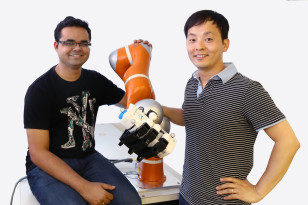
The ultra-fast robotic arm, seen here grasping a container of milk, was developed by scientists at the Learning Algorithms and Systems Laboratory (LASA) at the Swiss Federal Institute of Technology in Lausanne, Switzerland. ((c)EPFL)
Swiss scientists have developed a robotic arm that can catch items thrown at it with split-second accuracy.
Researchers say the new invention, described in IEEE Transactions on Robotics, catches various sized objects within 5/100 of a second.
The mechanized arm has three joints, a complex and sophisticated hand with four fingers, and measures about 1.5 meters long.
The scientists ‒ from the Learning Algorithms and Systems Laboratory (LASA) at the Swiss Federal Institute of Technology in Lausanne, Switzerland (EPFL) ‒ invented the device while investigating various robotic solutions for catching moving objects.
“Increasingly present in our daily lives and used to perform various tasks, robots will be able to either catch or dodge complex objects in full-motion,” said Aude Billard, who’s in charge of the Learning Algorithms and Systems Laboratory. “Not only do we need machines able to react on the spot, but also to predict the moving object’s dynamics and generate a movement in the opposite direction.”
The LASA scientists say the as-of-now unnamed robot could help with the space junk problem.
The device is already connected to the Clean-mE project at the Swiss Space Center at EPFL, which develops new technologies to help recover and dispose of the thousands of pieces of potentially dangerous debris accumulating in space around the Earth since the beginning of the space age.
Once the LASA robotic arm is installed on a debris-hunting satellite, its job will be to catch flying space debris. The size, shape and trajectories dynamics of these objects are only partially known. The scientists said that, for their arm catch a variety of flying things, it’ll need to develop and incorporate a number of parameters to allow it to react to unexpected events in record time.
“Today’s machines are often pre-programmed and cannot quickly assimilate data changes,” said Billard. “Consequently, their only choice is to recalculate the trajectories, which requires too much time from them in situations in which every fraction of a second can be decisive.”
As they developed the device, the researchers were inspired by how humans learn things ‒ by imitation, and trial and error. As a result, they developed a technique based on programming by demonstration.
Instead of giving the robot specific directions, this programming method shows it examples of possible trajectories and then the researchers manually guide the arm to the projected target, repeating this exercise several times. This allows the robotic to learn what it needs to do.
The wide range of objects used by the researchers to teach the robotic arm how to quickly grab objects included a ball, empty bottle, half full bottle, hammer and tennis racket.

Scientists Ashwini Shukla (left) and Seungsu Kim (right) are members of the LASA team that developed the dexterous robotic arm. ((c) EPFL)
The objects were selected because they provided the robot with a varied range of challenges to help it decide which part of the object has to be caught that doesn’t correspond to its center of gravity, such as the handle of the tennis racket. The bottle provided even a more of a challenge since its center of gravity moves several times during the course of its flight.
The researchers first began to teach their robotic arm by throwing an object at it several times. With the help of cameras planted in various locations around it, the robot created a model for the objects’ kinetics based on their trajectories, speeds and rotational movement. The research team then translated this model into an equation that allows the robot to quickly position itself in the correct path whenever an object is thrown. Within a few milliseconds before the object reaches it, the robot refines and fine tunes its conception of the trajectory for a real-time and highly precise catch.
The machine’s precision was even further enhanced when the researchers developed sophisticated controllers that help connect and coordinate the movements of the robot’s hand and fingers.
EPSL Video Demonstration of the New Ultra-Fast Robotic Arm ((C) EPSL)





















Comments are closed.